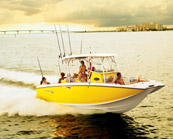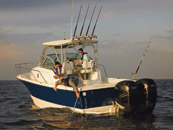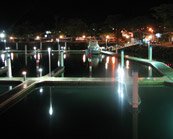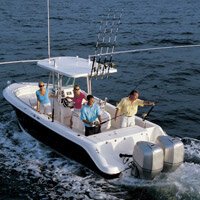| Thereâs no time like the present to give your boat a face-lift |
| Jun 8, 2009 |
| By Dave Ferrell and Charlie Levin |
While much of the country seems to be mired in a lot of gloom and doom about the economy, one thingâs for certain: The fish donât care one bit. Blue marlin will still snap off St. Thomas this summer; schools of yellowfin will still make their pilgrimage up the Atlantic Coast; and the stripeys wonât miss their California vacation come September. So thereâs no excuse not to shine up the old girl and take her out fishing.
As a bonus, the slower-than-average boat market has many builders focusing on yard work to tide them over, so not only can you get a deal on a new boat right now, you should be able to find a bargain or two when you get ready to freshen up your old ride. Below are several areas that start showing their age long before most boats are ready to retire. With a little time and investment, you can get your old girl back in the game, or at least get the most out of her come trade-in time.
Dock Appeal
Few things give away a boatâs true age faster than a worn and weathered paint job. No matter how careful you are with your boat, you will undoubtedly incur dings, scratches, fading or other blemishes over time, especially in high-traffic areas such as the cockpit, gunwales and covering boards. And though you might not visibly see the bottom paint when a boat sits in the water, a shoddy bottom job will also cause you grief.
When it comes to painting any part of a boat, preparation is key. The basic formula that all painters go by is simple: Spend 80 percent of your time doing prep work and 20 percent painting (some folks say itâs more like 95 percent prep, but you get the point).
"If not prepped properly, the paint job wonât hold up, and youâll see it right from the beginning," says Tripp Nelson of Alexseal Yacht Coatings.
Not only will you see areas that did not get the proper attention, your new paint might also start chipping off. "The biggest mistake when painting decks is not sanding enough," says Billy Maxwell, a custom boatbuilder whose North Carolina company BB Boats also takes on extensive refit projects. "If you donât sand thoroughly, new paint wonât stick, and when you hit it with a hose, it can lift off."
Thankfully, todayâs paints, both topside and bottom, have come a long way in terms of longevity and durability, but youâll still need to consider a new paint job above the waterline about every 10 years and a new bottom job every other season or more. The life of your paint depends on your maintenance routine, the number of coats and the type of paint applied.
"You need to protect the finish in between paint jobs," says Bob Donat, marketing manager for Interlux. "Clean it well with soap and water, and use a proper water softener that wonât leave spots."
Sun, bird droppings, careless mates and pollution can all wreak havoc on your shiny paint job. When you do find a blemish, itâs best to consult with the paintâs manufacturer to make sure whatever polish you use is compatible with the paint. The same can be said for spot repairs. If thereâs a scratch or section of blistered gel coat on your boat, you can make a small repair, but blending the colors is an artwork few can master. For very small scratches, a touch-up kit might fix it to where itâs not noticeable. When dealing with a good-sized spot, however, consult with a yard.
"A big scrape on the side of a boat from a blue marlin might require filler and primer and is probably best left up to professionals," Donat says. "Spot repair is a fine art, but if you can get a tape edge, youâll probably be OK. If you canât find a sharp edge to end on, itâs difficult to blend in, but it can be done."
The subject of bottom paint might not be one of the sportâs sexiest talking points, but the role it plays in your boatâs performance cannot be denied. When itâs time to address the bottom, you want to start clean. Hard bottom paint, once the industry standard, builds up over time, causing chipping and flaking, and it makes your bottom look like Swiss cheese if not properly applied. If your bottom has several layers of old paint, strip it clean before priming and starting fresh.
Todayâs polishing bottom paints actually get smoother over time and wear off on their own. Many owners will apply two layers of paint â for example, a black undercoat and a blue topcoat. That way, once the black starts to show, you know itâs time for a new coat of paint.
The number of bottom-paint products on the market today is mind-blowing. You can choose from all sorts of colors and applications, but its antifouling properties and longevity are most important. You need to match up the paint with your local conditions. The more slime and barnacles you keep off the bottom, the faster and more efficient youâll run â and youâll look good doing it. Do some homework and pick the best product for your boat. "The best people to talk to are those who deal with product on a daily basis â boatyards, manufacturers and captains," says Nelson.
Upgrading Your Helm
Few things in the marine marketplace change faster than electronics. Manufacturers keep improving their products at alarming rates, adding 3-D features, improved charting software that covers larger areas, night vision, high-definition radar â the list goes on and on. While upgrading your electronics suite annually to keep up with the latest and greatest may not be a realistic option, you should definitely consider a makeover of your helm station when refitting your boat.
All of todayâs major electronics companies make NMEA-2000-certified products, which means the different components can "talk" to one another via a data bus. Thanks to this technology, you can clear away some of the clutter in your electronics box and use just one or two monitors to display all the information you need from your chart plotter, fish finder, computer, video feeds, engine gauges and more.
"You can take any monitor made by any company and black-box everything else under the helm to give it that clean-screen look," says Dominick LaCombe Jr., director of operations at IMS American Marine Electronics. "Itâs like separating the guts from a computer and putting all of
The end result provides a cleaner-looking helm thatâs uncluttered with fewer units to grab the captainâs eye. To create that look on an existing helm, you might need to address a series of holes in your console for existing electronics. Surprisingly, filling in the gaps and creating a seamless dash is not a big deal.
"Thereâs a number of things you can do," LaCombe says. "You can start fresh and have a new helm made or retrofit what youâve got by filling in the voids and repainting." When updating the dash, you can choose from a number of materials such as fiberglass, teak or even carbon fiber.
Once youâve got a clean helm to work with, now comes the fun part: picking out a new set of electronics. "When a new customer comes to me, I find out what he currently has," says Joe Johnson of Southern Marine Electronics. "If heâs happy with what he has, Iâll go to the same manufacturer and see if thereâs a logical upgrade. You need to look at how they use the boat and whatâs the best fit."
Every captainâs preferences or tastes vary a bit when it comes to manufacturers, models and needs, so itâs best to decide which piece of electronics is most important to you and build from there. Do you want to start with the depth sounder and transducer, or do you need to address the radar first? And remember that the captain uses the electronics the most, but the owner signs the checks. Make sure everyone is on the same page before installing any new gear.
"We find most of the upgrades begin with the plotter," Johnson says. "Thereâs been a lot of advancements in charting, and you canât even buy charts for some of the older stuff anymore. New transducers are probably second to that. You want to match up the right transducer to that new fish finder."
Whenever you consider upgrading your electronics suite, donât skimp, and try to use the existing wires. "We try to rewire at any cost," LaCombe says. "We have no idea whatâs gone on with the wiring over the years or how many splices are in there that might fail. A $40,000 package could end up useless if you use the old wire."
To get the most out of your electronics upgrade, make a list of what you want, and find the right dealer or installer who can make it happen without trying to sell you stuff that you really donât need.
On the Deck
Nothing makes a boat look shabbier than a worn-looking teak deck and transom covering boards baked to an unappealing gray by the harsh tropical sun. The rest of the boat may shine like a new penny, but if the cockpit teak looks bad, you and your boat wonât make a good first impression. After all, itâs the first place you step when coming on board.
Upgrading your teak comes down to two options:
1. hitting your deck with a sander and a lot of elbow grease, or
2. replacing the whole thing in one shot.
John Bayliss of Bayliss Boatworks says the amount of material you have left determines what you should do. "If you have plenty of teak left and if it was a good installation in the first place, you can redo it â you can bring it back," says Bayliss. "But if the teak is coming loose and lifting off the substructure, youâre going to have to start from scratch and rip it out. You need to have at least a 1/2-inch of material left after sanding on the covering boards â and even thatâs on the extreme low side. The bare minimum on the deck is 1/4 of an inch, and once again, that also depends on the initial installation."
Bayliss says his workers frequently take off up to an 1/8-inch of material with the sander on some of the tougher jobs. But although you might lose a little wood during a reconditioning, you should save some dough by not having to do a refit. "You can spend between $1,200 and $2,500 to sand and get your deck into good shape â and about the same amount for the covering boards. If you have to replace any of the caulk, the rubber stuff in between the boards, then it will run you more. But to replace the whole deck, it will cost between $10,000 and $20,000, depending on the size, and again, about the same for the covering boards."
Pretty pricey to be sure, but itâs not all labor thatâs driving the cost up. "The price of good boards keeps getting higher," says Bayliss. "A single large board for a covering board can cost more than $2,000 in the rough ââ and most need at least three. Thatâs one thing that isnât dropping in price â they arenât making any more old-growth teak."
With that said, piecing together a nice transom and deck isnât a job for the weekend warrior. "A good installation is imperative, so you shouldnât let your brother-in-law do it just to save a few dollars," says Bayliss.
Once you get that deck revitalized, stay away from the harsh cleaning chemicals to keep it looking its best for as long as possible. "If used too often, chemical cleaners start to strip away the soft grain of the teak â leaving the hard grain and ridges behind," says Capt. George Sawley. "Instead, use a soft brush, some watered-down sudsy ammonia and the "B" part of the teak cleaner (brightener) â not the "A" part, which is the acid â to clean your teak. This reduces the amount of sanding youâll have to do in the long run and saves your paint, lettering, aluminum tower legs and the chrome on your fighting chair from harsh acids."
Heavy Metal
Nothing personifies a sport-fisher like a shiny set of outriggers and a tall tuna tower. When outfitted with these two tools of the offshore trade, any boat seems to sit a bit higher in the water and takes on an air of superiority to the surrounding cruisers sitting at the dock. At least thatâs what sport fishermen think.
Just as with most of the metal tools youâll find bolted to a sport-fisher, outriggers suffer greatly when not maintained properly. Salt mist and direct sunlight wreak havoc on unprotected anodized aluminum, so age doesnât really have a bearing on when you might need to replace or restore a set of riggers â it has much more to do with how well theyâve been taken care of in the past. According to Darrin Asher of Rupp Marine, "You should probably think about replacing your outriggers once they start getting failures due to things braking â collars, guy wires, etc. But we see 20-year-old pairs that look great and some five-year-old ones that are shot."
The first thing to do is find out what youâve got. Asher recommends using some elbow grease to clean things up for an evaluation. "Give them a good freshwater washdown, and hit them with a soft brush â youâd be surprised how much oxidation and salt this can knock off," he says.
After a good wash, clean the outriggers with some bronze wool and the aluminum cleaner of your choice. "Use bronze wool, with a cleaner like Aluma Guard. Bronze wool is aggressive on the oxidation but wonât hurt any anodizing thatâs left. Once they are clean, give them a good coat of Collinite wax, either their Barrier or Insulator," Asher says.
If, after all this work, your outriggers start to haze out again after about a week, then itâs time for a new set.
"Basically, you can get a tune-up and cleanup for about $300 to $400 â if nothingâs broken and you take them off and bring them to us," says Asher. However, that represents a considerable savings over a shiny new pair, which can cost $5,500 to more than $12,000 or higher.
Aluminum towers are a bit more permanent and expensive than outriggers, so most owners will do whatever they can to brighten up an older tower or flybridge setup instead of replacing them. Tim Bausch of Bausch American Towers says the decision usually becomes a monetary one but, "If the tower is pitted real bad, thereâs no way, or amount of money, thatâs going to make that pitting go away."
Painting these old towers might have been a good option in the old days, but unless you are planning on doing it yourself, the money spent on prep work makes it a fairly expensive project â not too much less than replacing the tower.
"A lot of folks freshen up the look of their old sportfishers by adding new hardtops. If the metal is still good, we can mold in new spreader lights, modify the existing hardtop or add on a full tower. By changing its lines and bringing a boatâs design up to the times, a new tower can make an old boat look like a brand-new one, and a completely different one at that," says Bausch.
Shared with Permission by Marlin.
Â
Â
Â



